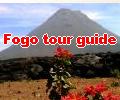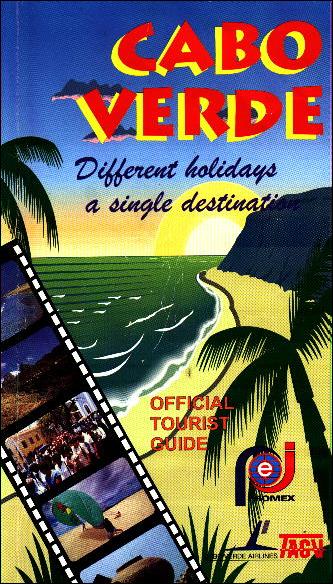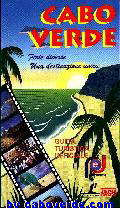
Location
The island of FOGO west of Santiago, is almost round in shape, and looks as if it is just a volcanic mountain.
The surface area is 476 Km2 and, although only the fourth biggest island of the Archipelago, it is the highest with the top of the volcano reaching a height of 2829 m.
The volcano is in fact the main tourist attraction of the island. The volcanic cone rises from a sort of plateau about 8 km in diameter, called CHÃ DAS CALDEIRAS the walls on the western side reach almost 1000 m and end in a crater 500 meters in diameter and 180 meters deep.
This is truly the most spectacular scenery in the whole of the Archipelago. The original volcanic cone must, at one time, have reached a height of 3500 m. The volcano was active right up to the XVIII century, when the main cone ceased activity and all that remained as testimony to it were the vulcanic vapours and deposits of sulphur.
There have been sporadic eruptions and the last one was in 1951, when the lava poured out of one of the two chimneys on the southern side of the volcano.

History
FOGO was discovered at the same time as SANTIAGO and MAIO, on May lst.1460. At first it was called S.FILIPE but later, and quite approprieately its name was changed to FOGO (Fire).
Once discoverd it was immediately occupied, in order to expand the agriculture in SANTIAGO. The two mam agricuítural products introduced were coffee and grapes. The coffee was weIl known for its high quality and special aroma. The wine produced, called Manecom, was also well known and at one time was exported to Brasil. Other activities also developed at the same time, the famous cloth weaving for example. As a result of this development, villages grew up in S.FILIPE, ALDEIAS da IGREJA,
MOSTEIROS and FAJAZINHA.
The whalers were frequent visitors to the island during the XIX century and not surprisingly many of the inhabitants that joined them ended up in America. These emigrants returned later to the island much richer than when they left and the result was a change in the social structure of the island. They bought out the most important families at the time, who were forced to sell their possessions due to the effects of terrible droughts.

Ethnography
Religious and Other Festivals
One of the biggest cultural celebrations on FOGO takes place between the last week of April and the 1st of May, and is called "The Festivals of Bandeira de São Filipe". Horse racing, dancing, mass and processions are all part of this event. Special dishes are also prepared for this festive occasion.
l3th of MAY -
This is the day of the Patroness of Concelho dos Mosteiros. This is a popular religious feast that attracts people coming from all parts of Fogo, as well as the people of Mosteiro who are now residing on other islands and abroad.
Food and Drink
The food here is rich in typical dishes that are prepared in a special and traditional manner and served on festive days. The aromatic coffee and the local wine "Manecom" are also part of the menu.
Entertainment and Sport
The spectacular scenery is an invitation in itself to take a bike ride or to simply take a walk.
For those who are feeling more energetic, the four hour climb to reach the top of the peak is quite a challenge but well worth the effort.

Places to Visit
S.FILIPE
Its predominant characteristic is the politicians "sobrados", witnesses to the power held by the great land owners of yesterday. The Historic Centre of the City of S. Filipe, with precise architectonic lines, invites us on an interesting and rich trip to the bygone days of the island. Looking out across the pleasantly arranged plazas and squares, we can easily see the "Cemitério Velho", a constant reminder of the old slave-based society. Known as the cemetery for the whites, only the wealthy landowners of European descent could be buried there. The Mother Church (Igreja Matriz)
PICO DO VULCÃO (Volcano Peak)
Leaving S.FILIPE or MOSTEIROS, take the road to CHÃ DAS CALDEIRAS, and for those who are feelling fit, a hike up the peak is well worth the effort. In CHÃ DAS CALDEIRAS, there is a magnificent natural park called MONTE VELHO, where there are some marvellous and truly enormous trees, which contrast greatly with the aridness of the rest of the island
SALINAS DE S.JORGE
North of S.FILIPE is a magnificent beach of black sand with a number of beautiful grottos and reefs.
OTHER PLACES OF INTEREST
COVAS DE MOSTEIROS - here there are three craters to be seen.
NOSSA SENHORA DO SOCORRO is a small chapel overlooking the sea. The Church of S.LOURENÇO and PONTE VERDE 15 km from S. FILIPE are also
points of interest.

















